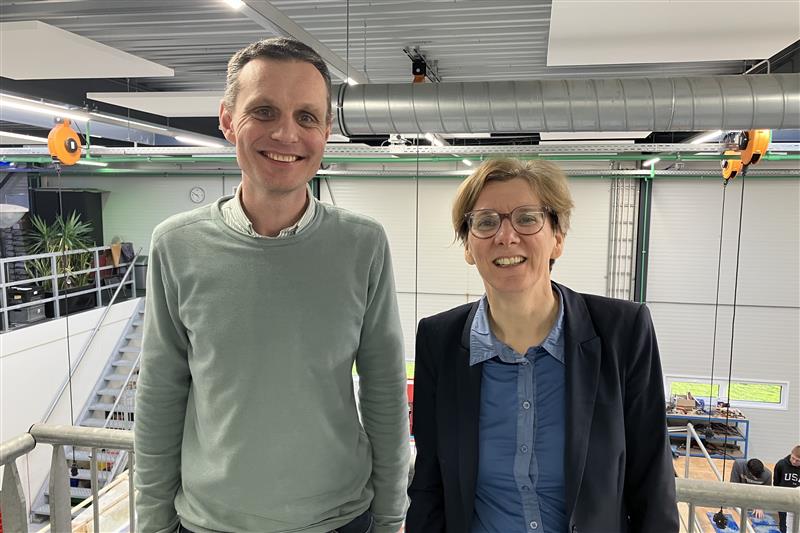TranSIT: working smarter with digital technologies
22 April 2025
The Smart Sustainable Manufacturing research group is investigating in TranSIT how SME manufacturing businesses can optimise their processes by using digital technologies, such as robotisation.

How can manufacturing SMEs work smarter and more efficiently? Digital technologies offer many opportunities, for example to optimise production processes or better identify risks. But where do you start? The TranSIT (Transferable Smart Industry Templates) research project helps businesses do just that. THUAS lecturer Rufus Fraanje and professor Jenny Coenen of the Centre of Expertise Digital Operations & Finance of The Hague University of Applied Sciences explain the benefits of TranSIT for SMEs.
Insight into production risks
“One of the biggest challenges for manufacturing businesses is to make a product right the first time, without errors or waste”, says Rufus Fraanje. “Particularly businesses that produce single pieces or small series find it difficult to properly assess all risks in advance”.
To support businesses in this, the TranSIT research team developed a system that maps production risks in a structured way. This approach works with a traffic light system (green, yellow, red) to classify risks. Fraanje: "This allows you to detect potential bottlenecks at a glance. That makes it easier to take targeted action, and helps avoid waste and wasted time".
Reduced search time thanks to smart robot
A second part of TranSIT focuses on the warehouse. Many manufacturing businesses lose time because parts for the production of goods are in different places. Together with students, the researchers developed a prototype of a robot that solves this: the tag mapping robot.
“This robot moves independently through the warehouse, scans RFID tags and QR codes and accurately records where parts are located”, explains Fraanje. “As a result, employees no longer have to search, but can walk straight to the right spot. This saves time and makes the production process much more efficient. The prototype already works well, although there is still room to further improve reliability”.
Steering smarter with data visualisation
The third part of the research revolves around combining different types of data. For example, location data of parts is linked to dashboards that operators have already been using.
“On such a dashboard you can see not only where a part is located, but also information about the production time of machines or malfunctions”, says Fraanje. “In the future, you could even use this data to plan the ideal production route, although that falls outside the scope of this project”.
Achieving the same thing with fewer people
"For all involved, these are exciting developments", says Jenny Coenen, professor in Smart Sustainable Manufacturing. "As researchers, we contribute to the future of manufacturing businesses. With that, our research fits in nicely with the Future of Work theme of the Centre of Expertise Digital Operations & Finance: how can we maintain production levels in the future, with fewer professionals, by deploying people where they add the most value? With our research, we help SMEs optimise their processes and offer students the opportunity to actively contribute to innovative, practice-oriented research”.
Multidisciplinary collaboration
“Our research takes place at the intersection of several disciplines”, adds Rufus. "That is why we collaborate with undergraduate and graduate students from various degree programmes, such as Applied Mathematics, Mechatronics, Industrial Engineering, Electrical Engineering, Mechanical Engineering, Industrial Design, Next Level Engineering and ICT. This collaboration provides valuable knowledge exchange".
The continuation
In the coming period, the team is finalising the risk analysis system and improving the prototype of the tag mapping robot. The researchers mainly want to demonstrate that the technology used works well. “We have no plans to put the robot into production at this time”, says Fraanje. “But our work does offer many opportunities for further research. Consider using AI and decision support technologies to help less experienced employees acquire new knowledge more quickly”.
Working together with businesses
The prototypes are developed in close collaboration with businesses. For example, VDL TBP collaborated on the development of the methodology for production risks. The New Makers and Boers & Co contributed to the tag mapping robot and dashboards. Technicare and Reurings Precisie Plaatwerk provided some great case studies. researchers from NHL Stenden and Fontys University of Applied Sciences are also participating: they investigate how the methods can be applied to other manufacturing businesses.
Connected to other research projects
Jenny: "We also collaborate with colleagues from the Future Urban Systems research group at The Hague University of Applied Sciences. In our lab, we collaborate with SMEs to investigate which digital skills their employees still need to future-proof the organisation. In addition, in the Capability Booster project, together with other universities of applied sciences, we are developing course materials that teach professionals how to work with the latest digital technologies, such as dashboards and tagging. The insights from TranSIT tie in well with this. This works both ways: we help organisations to work smarter and they enrich our research with valuable practical experience”.
More information:
- Read more about the research group Smart Sustainable Manufacturing
- Read more about the Centre of Expertise Digital Operations & Finance
- Neem contact op met onderzoekers Rufus Fraanje en Jenny Coenen